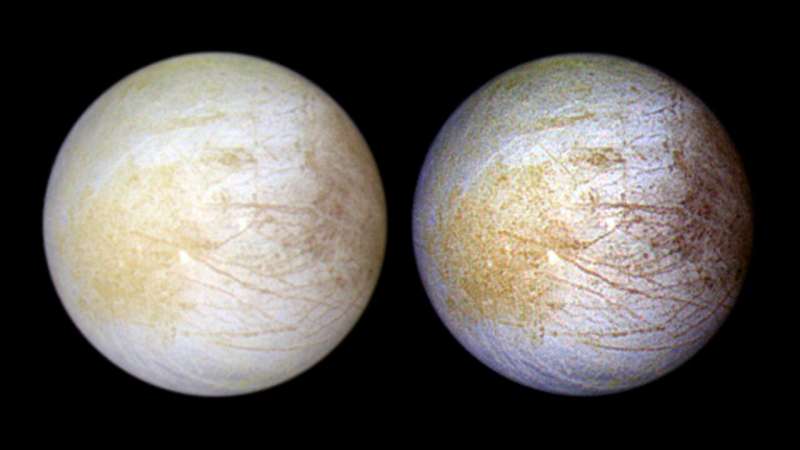NASA’s Hubble Space Telescope studies of Jupiter’s ice moon Europa showed the presence of continuous water vapor but only in one hemisphere, for some reason. Europa has a huge ocean under its ice surface, which may give helpful circumstances for life. This finding improves astronomers’ understanding of the atmospheric structure of ice moons. It puts up the foundation for future scientific missions to investigate whether an atmosphere half a billion kilometers from the Sun might support life.
Europa is one of Jupiter’s four Galilean moons. It is the sixth-largest moon in the Solar System, with an ice-covered surface and huge liquid oceans beneath its hard crust. Many people in the space and science sectors think that life exists deep under Europa’s surface in that ocean. Europa may not be as famous as its Mars and Moon, but it hides plenty of mysteries that are just waiting to be discovered.
Observations of water vapor on Europa in the past are related to crests exploding through the ice, as seen by Hubble in 2013. They are similar to geysers on Earth, although they may reach heights of more than 60 miles. They create thick drops of water vapor in the moon’s atmosphere, with a surface pressure of one billionth that of Earth’s.
The latest findings also reveal equal levels of water vapor spread through many areas in Europa as per Hubble images from 1999 to 2015. This leads to the endurance of a water vapor atmosphere only in Europa’s hemisphere near the region of the moon, which is always in the opposite direction of its orbit. The reason for this disproportion between the leading and following hemispheres is yet to be found. This finding is based on a novel study of Hubble pictures and spectra, which was recently used to know the existence of water vapor in the atmosphere of Jupiter’s moon Ganymede.
The discovery of water vapor on Ganymede and Europa’s sides helps to know about the atmospheres of these icy moons. The discovery of water availability on Europa is different from on Ganymede since Europa’s surface temperatures are lower than Ganymede’s.
Europa’s surface is 60 degrees Fahrenheit colder than Ganymede’s because it reflects more sunlight. The maximum temperature on Europa is minus 260 degrees Fahrenheit which is a lot chilly. This discovery shows that water ice is melting or changing directly from solid to vapor at lower temperatures without even turning into a liquid on the Europa’s surface, as it does on Ganymede.
They went through old Hubble records to discover the picking of ultraviolet ways of Europa from 1999, 2012, 2014, and 2015 while the moon was at multiple orbital locations. All of these observations were made using Hubble’s Space Telescope Imaging Spectrograph (STIs).
The data collected from ultraviolet, STIS helps calculate the amount of oxygen, which is one of the water elements in Europa’s atmosphere. It also helped reduce the presence of water vapor by understanding the magnitude of emission at different wavelengths.
This discovery helps in future missions, such as NASA’s Europa Clipper and the European Space Agency’s Jupiter Icy Moons Explorer (JUICE) mission, to investigate Europa (ESA) deeper. Learning about the formation and development of Jupiter and its moons also helps astronomers determine huge planets orbiting other stars.

